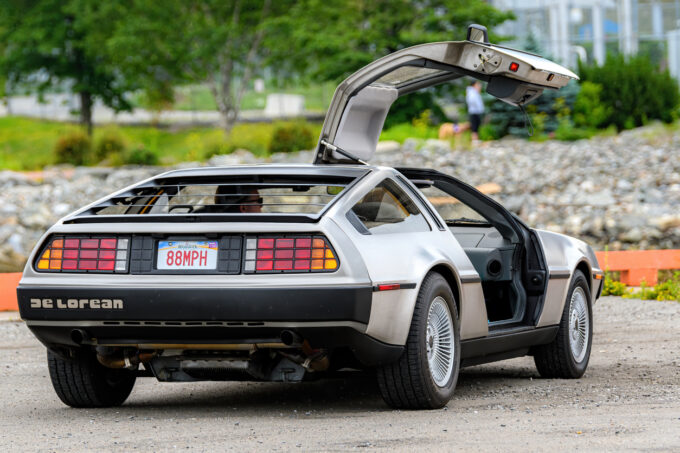
In the final scene of Back to the Future, Doc Brown prepares to take his time-travelling DeLorean into the future. Marty warns Doc that they don’t have enough roadway to get the machine up to 88 mph for the time jump. And then Brown famously says: “Roads? Where we’re going we don’t need roads.” Cue the flying car, and roll credits!
In the 1989 sequel, we learn that Marty and Doc travel via flying DeLorean to the distant future. Specifically, to that far-off, technological wonderland known as … 2015. (Spoiler Alert: There are lots of flying cars in 2015. Not to mention hoverboards and self-lacing shoes.) Eight years after those events, is this all just Hollywood make believe? Or are flying cars actually real? And if so, how are they being controlled for export?
Flying cars: fact or fiction?
Long before Back to the Future, the idea of flying cars captured the imagination of industrialists, engineers and more than a few science fiction writers. In 1940, none other than Henry Ford predicted: “Mark my word: a combination airplane and motorcar is coming. You may smile, but it will come.” Over the decades, various companies – both automotive and aviation – have attempted prototypes of personal air vehicles. One of the most successful early examples was the Taylor Aerocar.
The design requirements and limitations make this futuristic idea seem like mere fantasy. Among other things, a viable flying car must:
- Be capable of safe operation (on the road and in the sky);
- Be environmentally friendly;
- Have flight controls that can be operated by drivers who aren’t pilots;
- Deliver higher power than road cars at reduced weight;
- Be affordable;
- (Most experts agree) be able to take-off and land vertically, thereby eliminating the need for lengthy runways.
Despite these daunting restrictions, many companies are moving forward with designs. This includes large companies like Airbus, Embraer, and Bombardier – all who have announced plans to produce advanced air mobility vehicles. One site predicts three cars that will see actual production within the next 1-2 years. (One of them only costs a mere $300k!) Then there are startups, like SkyDrive in Japan, which anticipates its SD-05 vehicle going into production by 2025.
Just how many prototypes are there? It’s tough to say. The eVTOL Aircraft Directory currently lists 797 different types of prototype vehicles in various stages of development. This includes wingless multicopters, hoverbikes, personal flying devices and electric rotorcraft. With all this R&D underway, it seems now more than ever that we’ll soon be seeing flying cars on the road in the sky.
How are they controlled? It’s all about the tech!
So just how is that flying car parked in your driveway controlled? For example, could you fly it to Mexico for vacation? Can your French neighbor borrow the keys? Or would that be a “deemed export”?
A lot of the focus is on electric vertical takeoff and landing (eVTOL) vehicles and technology. In the United States, much of the technology for developing eVTOL applications is in Category 7 of the Commerce Control List (CCL) of the Export Administration Regulations (EAR) for “Navigation and Avionics.” Specifically, Export Control Classification Number (ECCN) 7E004. Under this ECCN, a license is required for a variety of reasons, including National Security, Missile Technology and Anti-Terrorism. This means an export license would be required for almost every country in the world – whether that’s sending the technology abroad or sharing it with Foreign Persons in the United States.
The licensing review and approval process can take months, as various governmental agencies provide input and then all of this is consolidated into a final “yes/no” approval for the license applicant.
Although no actual aircraft exists yet, once one does, it would likely be in the “9A” section of the CCL – “Aerospace and Propulsion.” Here we see a range of reasons for control, but you can expect that any kind of “personal air vehicle” would be more highly controlled than, say, commercial aircraft parts in ECCN 9A991.
An industry ready for takeoff
Most experts agree that advanced air mobility will be the next disruption in the aerospace industry. In fact, Deloitte predicts the market will grow to $115B by 2035 and account for 30% of the entire commercial aerospace industry in the United States. With that kind of growth, controls are sure to come.
First, you have the (obvious) security concerns when a nation of drivers is equipped with personal flying machines. Even if those machines are autonomous or “unmanned,” what if our enemies try to hack into the flight controls and weaponize the aircraft? There’s also the underlying technology. It may be applied to commercial applications, but could it also be retro-engineered and used for military purposes by our enemies?
Aside from these (admittedly major) worries, the United States has long been a world leader in the aerospace and defense industries. You can expect the country to try to maintain this advantage in eVTOL and other related aircraft, in part, by implementing tight controls for export. One example of this is Agility Prime – the U.S. Air Force program designed to accelerate eVTOL development and ensure that the United States maintains dominance in this field.
So, even though 2015 didn’t look exactly the way it was portrayed in the movies, we can expect the near future might have a “flying car” parked in every driveway. (You just might need a license to fly it outside the United States.)
Tom Reynolds is the President of Export Solutions, a consultancy firm which specializes in helping companies with import/export compliance.
